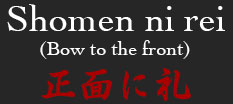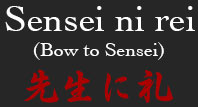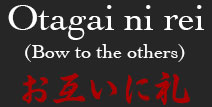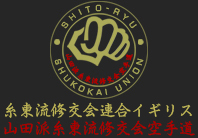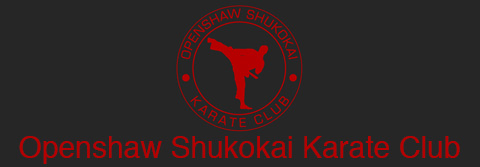Dojo Etiquette
"DOJO" is a word used in Buddhism to describe the room where the young Buddhist monks would diligently study, in oder to gain enlightenment.
Dojo-Kun (Dojo Rules)
Below is an extract from the YSSKU UK Members Handbook. For complete information on Karate, Club and Dojo etiquette see your handbook.
All Karate-ka should avail themselves with a handbook which is available through Sensei Denis Casey.
The handbook must be used alongside your dojo training and this website is to be used as an aid only and not instead of your dojo training.
"
Karate begins and ends with a bow. Without respect there would be no Karate
"
(Gichin Funakoshi)
Dojo-Kun
"DOJO" is a word used in Buddhism to describe the room where the young Buddhist monks would diligently study, in oder to gain enlightenment.
ONE WILL SEEK PERFECTION OF CHARACTER
(Hitotsu jinkaku kansei ni tsutomuru koto)
*
ONE WILL BE LOYAL
(Hitotsu makato no o mamoru koto)
*
ONE WILL ENDEAVOUR
(Hitotsu doryoku noseishin o yashinau koto)
*
ONE WILL RESPECT OTHERS
(Hitotsu reigi o omonsuru koto)
*
ONE WILL REFRAIN FROM VIOLENT BEHAVIOUR
(Hitotsu kekki no yu o imashimuru koto)
The purpose of the Dojo-Kun is to remind all the students in the Dojo, regardless of their rank, that the physical, mental, and spiritual growth they enjoy as a bi-product of their Karate training must also extend beyond the Dojo walls.
In order to derive the true benefits of Karate-do, each student must take the underlying principles of this art and make them a regular part of their daily life. When you leave the dojo, take the meaning of those words above with you. For it is in the everyday world outside that the true meaning of the Dojo-Kun is truly meant to be practiced.
The Meaning of the Dojo-Kun, to Seek Perfection of Character
This means that the art of Karate is more than just physical. All beginners, especially the young should taught the importance of character building through discipline and rigorous training. For the beginner, the character building process begins with perfecting techniques through repetition. The spirit to fight will be achieved as one gains confidence through development of stronger techniques. Train to bring out the spirit, not only to fight but also to overcome personal problems especially in times of sickness, domestic crisis or business problems. it is a long path to develop these spiritual values but once the concept is understood and experienced it will provide a lifetime benefit of inner strength.
LOYALTY
To be loyal is a strong Samurai tradition and is an extension of Confucius influence on the family and the martial arts. The loyalty is to, your sensei, Dojo and association. The student must always be loyal to his/her sensei and follow in much the same way as a medieval Samurai was bound to follow his feudal lord. While this may seem unusual in the present day, it is unreasonable to expect a sensei to teach all he knows to a student who is likely to leave for the slightest reason. The student must prove his loyalty over the years. The faith and loyalty extended to the sensei will be rewarded, in that greater amount of knowledge and wisdom will be passed on to the student. This bond between sensei and student is extremely valuable and is the basis of the training relationship.
ENDEAVOUR
To endeavour, means to have the complete dedication and commitment necessary to achieve mastery of Karate. In no case is mastery possible without strenuous effort and sacrifice on the part of the student. The endeavour must be of a sincere nature and not just superficial. Serious effort on the part of the student will be rewarded by improvement in technique and knowledge.
RESPECT FOR OTHERS
Respect for others is an important part of Japanese and Okinawan culture, therefore common to martial arts.
This is a reflection of the formal nature of the Japanese people who may be observed bowing in the Dojo, or as they go about their everyday life. Dojo etiquette is well defined. You bow correctly and show respect in everything you do and everywhere you go. Respect is extended to all senseis, fellow students, parents, educators, law, deceased, nature, etc.
"
In order to bow well physically, you must first learn how to bow well in your mind
"
REFRAIN FROM VIOLENT BEHAVIOUR
It is the responsibility of trained Karate-ka to refrain from violent behaviour, since a trained fighter can inflict serious injury upon others. The goal of Karate training is self-mastery, including mastery of one's behaviour and emotions. In situations where it is necessary to defend one's self, and no non-violent alternative may be possible. However, the tradition handed down by the Karate masters indicates that after a lifetime of training they felt they had failed if they were forced to resort to violent action against their fellow man.
Dojo Ethics and Code of Behaviour
The art of Karate-do places great emphasis on the development of the character of its students, and a code of behaviour is used, together with the physical training, so that technical skill, physical fitness and good behaviour become synonymous with Karate-do. The code is based on a mutual respect of Teachers and Students, and acknowledges that respect must be shown for seniority.
Karate and Dojo Etiquette
The Standing Bow (Rei - 礼)
Stand with your heels together, feet pointing outward like a 'V' (Musubi Dachi, see the Terminology Page). Keep your knees straight and relaxed; hands open at the outside of your legs, and fingers together. Bend at the waist, about 20 degrees forward, pause and unbend, straightening up.

Kneeling in Seiza (正座)
Place your left knee on the floor, then your right knee. Sit down on your feet. The big toes should overlap. Keep your back straight and shoulders relaxed. Rest your left hand on your left thigh and your right hand on your right thigh, so that your fingers point inward.
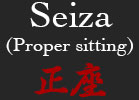
Bowing in Seiza
Slide your left hand from the thigh to the floor immediately in front of your left knee. Do the same with your right hand so that the right hand motion is slightly behind (in time) the left hand motion.
Your palms should touch the floor to show deep respect , bow at the waist, taking a little longer than for a standing bow (forehead comes close to the floor but does not touch it). Slide your hands back to their original position on the thighs, this time with your left hand slightly behind your right hand (in time).
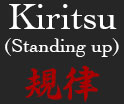
Starting the class
When your hear the words "line up" or "in line", stand shoulder to shoulder facing the front of the Dojo, in rank order. Try to line up so that the instructor standing before your line is right in the middle of the front line. If the class is so big that the senior student request you to make more than one line, try to line up so that the lines are approximately the same length.
Below are the commands that the sensei will use;
- "Seiza": Sit down in seiza so your knees are aligned with the person on your left.
- "Mokuso": (Quiet meditation) just lower your gaze, relax and breathe.
- "Mokuso yame": (End meditation).
- "Shomen ni rei": (Bow to the front) this is to show respect for your training space, to the institution of Karate-do and to the line of instructors who it to your instructor.
- "Sensei ni rei": (Bow to the instructor) When you are bowing, you can say "Onegaishimas" which roughly translated means "Please" (i.e. "Please teach me" etc.). At the signal of the instructor, get up quickly, but wait for the person on your left to begin to rise first.
Ending the class
This is the same as the opening sequence except, during the bow to the instructor, ("Sensei ni rei") you would say "Arigato gozaimashita" ("Thank you for teaching me"). At the end the instructor will stand, you should wait for the command "Kiritsu" (Stand up/Rise). Wait until the person to your left to stand before you do the same. All these Karate terms and many more can also be found on the Terminology Page.
